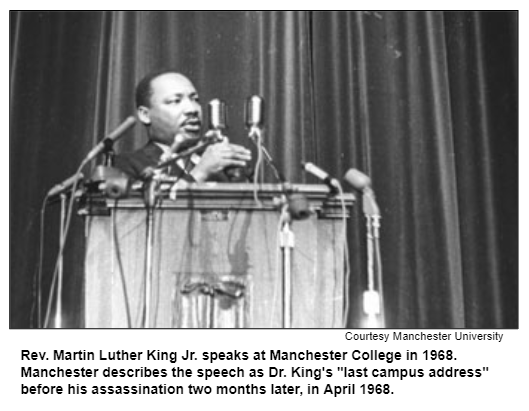
Saturdays, noon to 1 p.m. ET on WICR 88.7 FM.
Or listen live from anywhere on WICR Online!
Our call-in number during the show: (317) 788-3314
January 19, 2019
Rev. Martin Luther King's visits to Indiana
Both before he became a household name nationally and after he was a famous public figure, Rev. Martin Luther King Jr. made trips to Indiana. How those visits during the 1950s and '60s unfolded, where Rev. King stayed and other details, will be the focus of our show two days prior to Dr. Martin Luther King Jr. Day.

Nearly 10 years earlier, in 1958 when he was a young minister and civil rights leader in the South, 29-year-old Dr. King spoke in downtown Indianapolis at Cadle Tabernacle, a sprawling, Spanish-style structure that served as the site of conventions, religious gatherings, music concerts and a range of other events. Cadle Tabernacle, which was located at Ohio and New Jersey Streets, was demolished during the late 1960s.
In the decade between that speech and the talk at Manchester College near the end of his life, Dr. King periodically visited Indianapolis, often staying with the family of his close friend Rev. Andrew J. Brown (1921-1996), pastor of St. John's Missionary Baptist Church. Rev. Brown, one of Indiana's most prominent civil rights leaders of the era, marched with Dr. King in Selma, Ala., in 1965.
For our exploration of Dr. King's trips to Indiana - which also included a speech at Goshen College in 1960 - our studio guests will be:
- Rev. Thomas Brown, a professor at Martin University, radio host on WTLC-AM (1310) and the son of Rev. Andrew Brown. Because of the friendship between his father and Dr. King - as well as Rev. Thomas Brown's own civil rights work in Selma - he got to know Dr. King on a personal basis. Rev. Thomas Brown is the retired pastor of Ebenezer Missionary Baptist Church.
- Historian David Leander Williams, an adjunct professor at IUPUI. David has been a previous guest on Hoosier History Live when we have explored aspects of African-American history, including the jazz music scene that flourished along Indiana Avenue during the mid-20th Century. David is the author of a new book, Indianapolis Rhythm and Blues (Arcadia Publishing).
- And Susan Hall Dotson, coordinator of African-American history for the Indiana Historical Society. Susan will discuss Dr. King's visits and related topics during a day-long series of events Jan. 21 at the Indiana History Center in Indianapolis to celebrate MLK Jr. Day.
 Accounts about Dr. King's speech at Goshen College, which is affiliated with the Mennonite Church, describe it a "spellbinding lecture." The speech, which he delivered in 1960, occurred about one year after he had traveled to India to study Gandhi's techniques of nonviolence.
Accounts about Dr. King's speech at Goshen College, which is affiliated with the Mennonite Church, describe it a "spellbinding lecture." The speech, which he delivered in 1960, occurred about one year after he had traveled to India to study Gandhi's techniques of nonviolence.
At Goshen College, Dr. King discussed nonviolence. He also called on religious leaders to more strongly advocate for civil rights; Dr. King described most churches across the country as "segregated islands."
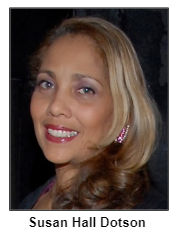
Rev. Andrew Brown was active in the Southern Christian Leadership Conference (SCLC), a civil rights advocacy organization; Dr. King served as its first president. Today, Rev. Thomas Brown is president of the Indiana Christian Leadership Conference, an affiliated chapter.
Just as streets have been named in honor of Dr. King in many Indiana cities - including Indianapolis, Evansville, South Bend, Gary and Elkhart - a street on the near-eastside of Indy was named Dr. Andrew J. Brown Avenue in 1986. In addition to serving as pastor of St. John's Missionary Baptist Church, which is located on the street named in his honor, Rev. Andrew Brown was one of the primary organizers of Indiana Black Expo during the early 1970s.
History Mystery
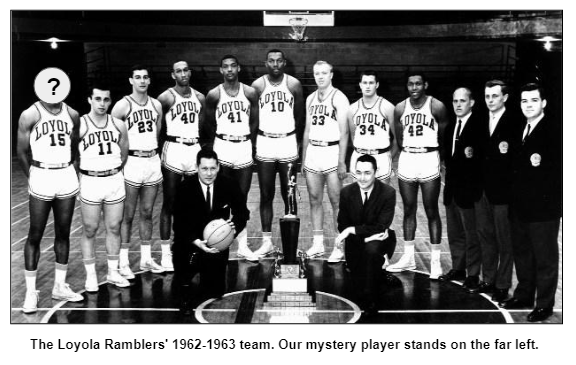
Major organizers of Indiana Black Expo in the early 1970s included Indianapolis civil rights leader Rev. Andrew Brown, a close friend of Dr. Martin Luther King Jr. and the father of our guest Rev. Thomas Brown. The inaugural Black Expo was a three-day event in 1971 attended by more than 50,000 people.
Celebrities featured at inaugural Expo events included a popular former player for the Indiana Pacers, which were then in the ABA (American Basketball Association). Our mystery player had been a basketball star at Loyola University in Chicago, leading the team to the 1963 NCAA championship. At the time of the inaugural Black Expo in 1971, he was working as the first African-American fundraiser for United Way of Central Indiana. During the 1970s, he became the first African-American sportscaster in the Indianapolis TV market.
In addition, he advocated for civil rights, working with the Southern Christian Leadership conference several years after Dr. King had served as the organization's first president.
Question: Who is our mystery man?
Please do not call in to the show until you hear Nelson pose the question on the air, and please do not try to win if you have won any other prize on WICR during the last two months. You must be willing to give your first name to our engineer, you must answer the question correctly on the air and you must be willing to give your mailing address to our engineer so we can mail the prize pack to you. The prize pack is a gift certificate to Story Inn, courtesy of Story Inn, and four admissions to GlowGolf, courtesy of GlowGolf.
Bobby Plump, "Milan Miracle" shot-maker, to speak at Hoosier History Live 11th anniversary party!
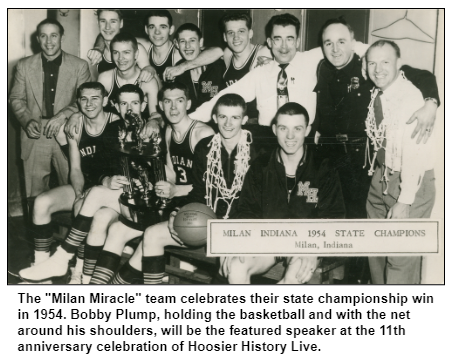
Once in a great while, the little guy wins.
In 1954, in what became known as the "Milan Miracle," a basketball team from a small, rural high school beat out the favored teams to capture the Indiana state championship, a feat immortalized in the 1986 movie Hoosiers.
 Legendary Hoosier Bobby Plump, who made the final, winning shot for the small Milan High School basketball team in 1954, will speak at Hoosier History Live's 11th anniversary party. The party will be held on Thursday, Feb. 28 from 5:00 to 7:30 pm at the Indiana Landmarks Center, 1201 N. Central Avenue, Indianapolis, IN 46202.
Legendary Hoosier Bobby Plump, who made the final, winning shot for the small Milan High School basketball team in 1954, will speak at Hoosier History Live's 11th anniversary party. The party will be held on Thursday, Feb. 28 from 5:00 to 7:30 pm at the Indiana Landmarks Center, 1201 N. Central Avenue, Indianapolis, IN 46202.
As our featured speaker, Bobby Plump will be helping to celebrate the success of another "small team" - the Hoosier History Live creative team. While quality journalism in newspapers, magazines and television news decreases, Hoosier History Live's independent production group continues to put out a compelling show and an informative newsletter each week.
And all the while expanding its reach as a podcast, available for free on iTunes and other popular podcast venues.
We invite all friends and supporters of Hoosier History Live to join the celebration as our guest. Come as you are, or (better yet!) dress in historic garb as your favorite character from the past. Watch our website for details and the RSVP form.
Thanks to our friends at Indiana Landmarks and Black Plate Catering for their support!
What happened to last week's show?
The heavy snowfall last Saturday prevented our WICR student engineers from making it to the studio, so we had to substitute a rebroadcast show. Our planned show, "Movies with obscure Indiana connections," featuring film historian Eric Grayson as Nelson's guest, is rescheduled to air live on February 16.
Nelson Price, host and historian
Molly Head, producer/project manager, (317) 927-9101
Michael Armbruster, associate producer
Cheryl Lamb, administrative manager
Richard Sullivan, senior tech consultant
Pam Fraizer, graphic designer
Garry Chilluffo, special events consultant
Please tell our sponsors that you appreciate their support!

 Acknowledgments to Monomedia, Visit Indy, WICR-FM, Fraizer Designs, Heritage Photo & Research Services, Henri Pensis, Aaron Duvall, Chloe Tyson, and many other individuals and organizations. We are independently produced and are self-supporting through organizational sponsorship and through individual contribution at the yellow button on our newsletter or website. For organizational sponsorship, which includes logos, links, and voiced credits in the show, contact Molly Head at (317) 927-9101 or email her at molly@hoosierhistorylive.org. Our media reach continues to grow via podcasting and iTunes.
Acknowledgments to Monomedia, Visit Indy, WICR-FM, Fraizer Designs, Heritage Photo & Research Services, Henri Pensis, Aaron Duvall, Chloe Tyson, and many other individuals and organizations. We are independently produced and are self-supporting through organizational sponsorship and through individual contribution at the yellow button on our newsletter or website. For organizational sponsorship, which includes logos, links, and voiced credits in the show, contact Molly Head at (317) 927-9101 or email her at molly@hoosierhistorylive.org. Our media reach continues to grow via podcasting and iTunes.
Thank you!
We'd like to thank the following recent, new and renewal contributors whose donations help make this show possible!
- Bill McNiece
- Tom Spalding
- Joseph Leak
- Melissa Martin
- Diane Dallis
- Yetta Wolen
January 26, 2019 - coming up
Indiana's Civil War governor and his historic house
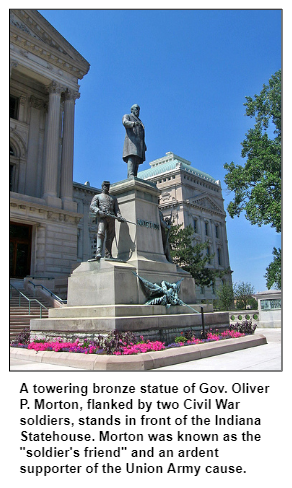
But Morton - an ally of Abraham Lincoln who came close to being the Republican nominee for U.S. president in 1876 - was a controversial figure. Critics have contended that Morton (1823-1877) was practically a dictator who abused his powers as governor during the Civil War.
To explore the impact and colorful life of Morton, who served as a U.S. senator representing Indiana following his stint as governor, Nelson will be joined by two distinguished guests:
- James Fuller, a history professor at the University of Indianapolis and the author of a new book, Oliver P. Morton and the Politics of the Civil War and Reconstruction (Kent State University Press), the first full-length biography of Morton to be published in more than 100 years.
- And Ron Morris, a history professor at Ball State University who is restoring Morton's home on the Old National Road (now U.S. 40) in Centerville, Ind. In 2012, Ron purchased the two-story house, which was built in 1848 and had been deteriorating badly.
Known as the "soldier's friend" and an ardent supporter of the Union Army cause, Morton even visited battlefields and traveled to Washington D.C. to plead with Lincoln to supply overcoats to shivering troops from Indiana. After the war, he was a fierce advocate for the civil rights of African Americans.

Before the Civil War, Morton had been an attorney, practicing law in the house that Ron Morris is restoring. Morton was one of the early organizers of the Republican Party in Indiana and, before that, had helped form its predecessor, the People's Party.
At the GOP convention in 1876 that ultimately settled on Rutherford B. Hayes as a compromise nominee for president, Morton "enjoyed widespread support," dropping out only after the sixth ballot, as Jim Fuller recounts in his biography. The enthusiasm for Morton as a presidential candidate persisted for several years, even after he had suffered a debilitating stroke that paralyzed his legs, rendering him unable to walk unassisted.
© 2019 Hoosier History Live. All rights reserved.
|
